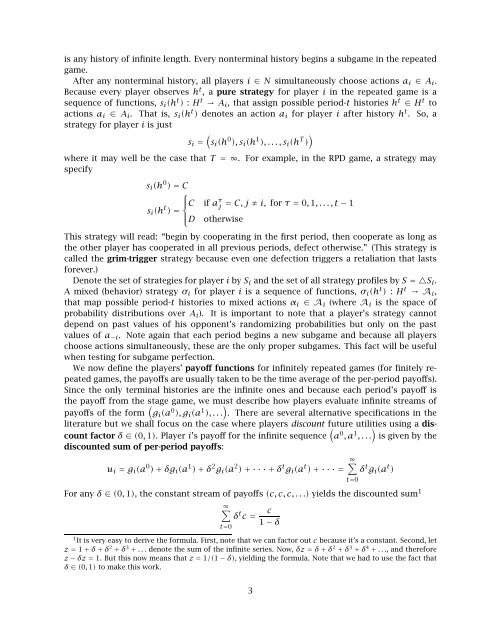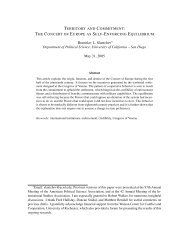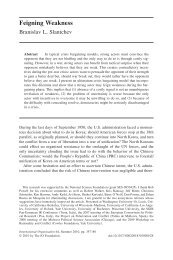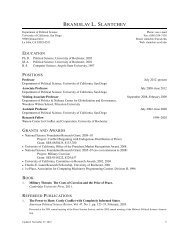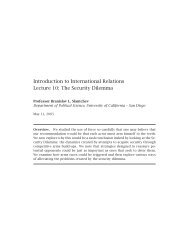Game Theory: Repeated Games - Branislav L. Slantchev (UCSD)
Game Theory: Repeated Games - Branislav L. Slantchev (UCSD)
Game Theory: Repeated Games - Branislav L. Slantchev (UCSD)
Create successful ePaper yourself
Turn your PDF publications into a flip-book with our unique Google optimized e-Paper software.
is any history of infinite length. Every nonterminal history begins a subgame in the repeated<br />
game.<br />
After any nonterminal history, all players i ∈ N simultaneously choose actions ai ∈ Ai.<br />
Because every player observes h t ,apure strategy for player i in the repeated game is a<br />
sequence of functions, si(h t ) : H t → Ai, that assign possible period-t histories h t ∈ H t to<br />
actions ai ∈ Ai. That is, si(h t ) denotesanactionai for player i after history h t . So, a<br />
strategy for player i is just<br />
si =<br />
<br />
si(h 0 ), si(h 1 ),...,si(h T <br />
)<br />
where it may well be the case that T =∞. For example, in the RPD game, a strategy may<br />
specify<br />
si(h 0 ) = C<br />
si(h t ⎧<br />
⎪⎨ C if a<br />
) =<br />
⎪⎩<br />
τ<br />
j = C,j ≠ i, for τ = 0, 1,...,t− 1<br />
D otherwise<br />
This strategy will read: “begin by cooperating in the first period, then cooperate as long as<br />
the other player has cooperated in all previous periods, defect otherwise.” (This strategy is<br />
called the grim-trigger strategy because even one defection triggers a retaliation that lasts<br />
forever.)<br />
Denote the set of strategies for player i by Si and the set of all strategy profiles by S =△Si.<br />
A mixed (behavior) strategy σi for player i is a sequence of functions, σi(ht ) : Ht →Ai,<br />
that map possible period-t histories to mixed actions αi ∈Ai (where Ai is the space of<br />
probability distributions over Ai). It is important to note that a player’s strategy cannot<br />
depend on past values of his opponent’s randomizing probabilities but only on the past<br />
values of a−i. Note again that each period begins a new subgame and because all players<br />
choose actions simultaneously, these are the only proper subgames. This fact will be useful<br />
when testing for subgame perfection.<br />
We now define the players’ payoff functions for infinitely repeated games (for finitely repeated<br />
games, the payoffs are usually taken to be the time average of the per-period payoffs).<br />
Since the only terminal histories are the infinite ones and because each period’s payoff is<br />
the payoff from the stage game, we must describe how players evaluate infinite streams of<br />
payoffs of the form gi(a0 ), gi(a1 <br />
),... . There are several alternative specifications in the<br />
literature but we shall focus on the case where players discount future utilities using a discount<br />
factor δ ∈ (0, 1). Player i’s payoff for the infinite sequence a0 ,a1 <br />
,... is given by the<br />
discounted sum of per-period payoffs:<br />
ui = gi(a 0 ) + δgi(a 1 ) + δ 2 gi(a 2 ) +···+δ t gi(a t ∞<br />
) +···= δ t gi(a t )<br />
For any δ ∈ (0, 1), the constant stream of payoffs (c,c,c,...) yields the discounted sum1 ∞<br />
δ t c = c<br />
1 − δ<br />
t=0<br />
1 It is very easy to derive the formula. First, note that we can factor out c because it’s a constant. Second, let<br />
z = 1 + δ + δ 2 + δ 3 + ... denote the sum of the infinite series. Now, δz = δ + δ 2 + δ 3 + δ 4 + ..., and therefore<br />
z − δz = 1. But this now means that z = 1/(1 − δ), yielding the formula. Note that we had to use the fact that<br />
δ ∈ (0, 1) to make this work.<br />
3<br />
t=0


